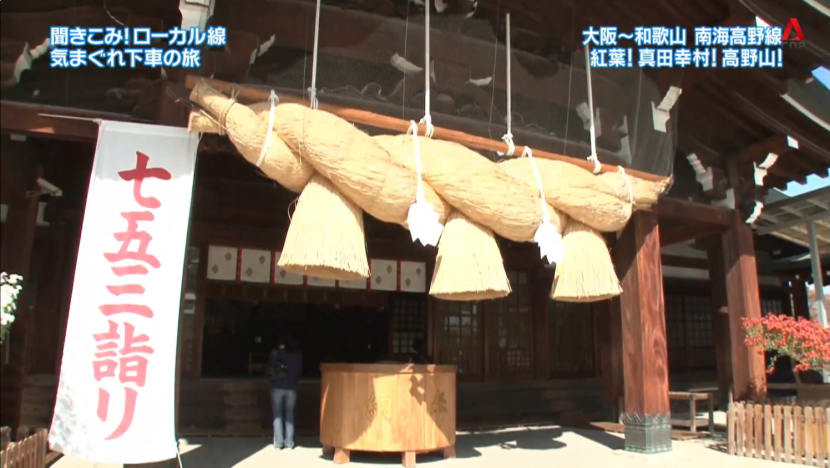Road Trip To Nankai Electric Railway - Part 1
A garage for trams, a branch shrine of the famous Izumo Taisho which is known for its "sacred water", and a museum dedicated to Japan's oldest reservoir are among the places highlighted this week.

This week, we embark on a two-day trip of enquiry and discovery on Nankai Electric Railway’s Koya Line. It connects Osaka Prefecture and Wakayama Prefecture. There are 41 stations, spanning a total distance of 64.5km. The Nankai Electric Railway was established in 1885. The Koya Line, connecting Shiomibashi Station to Gokurakubashi Station, was opened in 1929. Our journey begins from Shiomibashi Station in Naniwa Ward, Osaka City. Our goal is to reach the terminal station, take a cable car and visit the World Heritage Site of Koyasan, which was established 1,200 years ago.
We catch the 9.10am train and initially plan to get off at Asakayama Station. However, a passenger on the train suggests we check out a garage for trams, located near Abikomae Station. So we decide to alight at Abikomae, one station before Asakayama, instead. We walk for 15 minutes to the Abiko Garage. Hankai Tramway is the only tramway in Osaka Prefecture and it runs through Sakai City. Since its opening in 1897, it has been known locally as "Chinden". There are currently 38 cars in total and 30 are covered in advertisements in different colours. These “Chinden” trams can be seen at the garage and are popular among the locals.
After this, we take the 10.40am train from Abikomae Station and head to Hagiharatenjin Station, eight stops away. The train crosses Yamato River and we arrive at Hagiharatenjin at 11am. Upon making enquiries, we are advised to visit the Osaka branch shrine of the famous Izumo Taisha in Shimane Prefecture. The former is located near Hatsushiba, one stop before Hagiharatenjin, so we have to walk back to that station. We learn there are branch shrines of Izumo Taisha in each prefecture of Japan. The Osaka branch shrine is also dedicated to the deity of Izumo Taisha, while the majestic roof of its main hall is built in the same way as Izumo Taisha in Shimane. Like the main shrine, the Osaka shrine is also believed to bring good luck in matchmaking.
We find out that many worshippers come to the Osaka branch shrine to drink the sacred spring water behind the shrine building. It is said to be good for healing illness, while also helping in growing crops. We go to Shinwaden, dedicated to a deity of water, and get to drink the water.
We next take the 12.35pm train and ask a passenger for recommended spots. He tells us about the Sayama Pond near Osakasayamashi Station. The oldest pond in Japan, it also has a museum dedicated to it. The passenger also suggests we visit Flour, a bakery near the pond which is known for its lunch menu. So we alight at Osakasayamashi Station and go to the bakery. We can see the Sayama Pond from the bakery. Flour opened about 10 years ago and the cakes made with seasonal ingredients are very popular. They also have their own pesticide-free farm and grow vegetables which are used in their dishes. The chef used to work as an official chef at the Japanese Embassy in the UK. We order the pasta lunch set meal and hashed beef, which is a limited dish with only 10 servings a day.
We next visit the museum near the pond which was recommended on the train earlier. It was built by Tadao Ando, an architect. Sayama Pond, a national historic site, has a circumference of about 3km and it is the size of seven Tokyo Domes. Built 1,400 years ago, it is believed to be Japan’s oldest dam-type reservoir. Many objects found in the reservoir, some of which are about 1,400 years old, are displayed at the museum. Part of the northern bank of Sayama Pond was cut out and it can be found at the museum too. The cross-section of the bank is 15m high and 60m wide. It has been renovated a few times and is made up of 12 layers.
We take the train from Osakasayamashi Station at 4.15pm and go to Kawachinagano Station, four stops ahead. We arrive at 4.25pm and start looking for accommodation. A resident mentions an old-fashioned hot spring inn called Kawachinaganoso. We walk to the inn, which is located in the Nagano hot spring town on the east side of the station. At the end of the Meiji period and in the Taisho period, the hot spring town was known as Gokurakuji Onsen.
The inn has rooms available but dinner is not included as it is quite late by now. So we ask the staff to suggest a restaurant. We are told about Nagomi, a tempura restaurant near Kawachinagano Station. It is run by the Kawachinaganoso’s former head chef. It is 15 minutes away from the inn by foot. Opened two years ago, the restaurant's speciality is perilla dumpling tempura, which is the manager's own creation. We order a platter with seven different kinds of tempura and a special salad with pike conger. We notice something interesting on the menu called sauce rice and decide to try that too. Its main ingredients are chicken and red pickled ginger, which are deep fried to make tempura. Rice is topped with shredded cabbage, seaweed and the freshly made tempura, after which a special sauce made by the manager - a mixture of tempura sauce and Worcestershire sauce - is poured on top.
Tips:
1) Railway fans should visit the Abiko Garage for trams, located near Abikomae Station
2) Try the “sacred water” at the Osaka branch shrine of Izumo Taisha which is believed to cure illnesses












